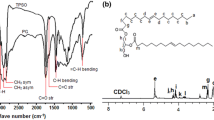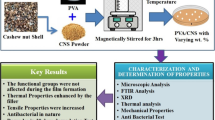Abstract
Bio-based polyurethanes (PU) prepared through green routes using technical cashew nut shell liquid (TechCNSL) for anti-corrosive application could protect infrastructures and addresses environmental concerns. The synthesis was carried out in situ by an acid-catalyzed condensation reaction of TechCNSL and formaldehyde (F) at 120 °C. The final structure was obtained through addition polymerization of TechCNSL-F with toluene diisocyanate (TDI) at room temperature (OH:NCO ratios: 1:0.8, 1:1 and 1:1.2) to form TechCNSL-F-PU. The characteristic properties of the coatings were influenced as a function of free –OH and –NCO groups that is influenced by the composition of TechCNSL used. The high coating resistance (Rc) and change in solution resistance (Rs) values along with lower coating capacitance (Cc) values supporting sufficient protection ability and compactness to the metallic substrate was determined by non-destructive electrochemical impedance spectroscopy (EIS) studies. Structural and progress of the reaction was evaluated by ATR/FTIR, whereas XRD revealed the amorphous nature of the hydrophobic films/coatings with a contact angle of 100° for TechCNSL-F-PU1:1. The variation in thermal stability with TDI concentration and glass transition (Tg) temperature was based on the degree of cross-linking density of the systems. The degree of cross-linking was calculated through estimation of gel content, which varied from 96 to 98% based on the concentration of TDI with thermal stability by max 265 °C. TechCNSL-F-PU1:1 shows excellent films/coatings adhesion, anticorrosion performance, chemical and mechanical resistance in the various chemical environment (water, 3.5% of HCl, NaCl and NaOH) and showed the best performance. These thermally stable and mechanically robust PU films/coatings can be projected for the corrosion protective applications.
Graphical abstract












Similar content being viewed by others
References
Miao S, Wang P, Su Z, Zhang S (2014) Vegetable-oil-based polymers as future polymeric biomaterials. Acta Biomater 10:1692–1704
Zafar F, Ghosal A, Sharmin E, Chaturvedi R (2019) A review on cleaner production of polymeric and nanocomposite coatings based on waterborne polyurethane dispersions from seed oils. Prog Org Coat 131:259–275
Ghosal A, Rahman OU, Ahmad S (2015) High-performance soya polyurethane networked silica hybrid nanocomposite coatings. Ind Eng Chem Res 54:12770–12787
Ghosal A, Shah J, Kotnala RK, Ahmad S (2013) Facile green synthesis of nickel nanostructures using natural polyol and morphology dependent dye adsorption properties. J Mater Chem A 41:12868–12878
Zafar F, Ashraf SM, Ahmad S (2007) Studies on zinc-containing linseed oil-based polyesteramide. React Funct Polym 67:928–935
Khan S, Laxmi ZF, Nishat N (2016) Development of bio-derived nanostructured coordination polymers based on cardanol–formaldehyde polyurethanes with ‘d 5’Mn (ii) and ‘d 10’Zn (ii) metal nodes: synthesis, characterization and adsorption behavior. RSC Adv 6:50070–50082
Ghosal A, Ahmad S (2017) High-performance anti-corrosive epoxy–titania hybrid nanocomposite coatings. New J Chem 41:4599–4610
John G, Nagarajan S, Vemula PK, Silverman JR, Pillai CKS (2019) Natural monomers: a mine for functional and sustainable materials—occurrence, chemical modification, and polymerization. Prog Polym Sci 92:158–209
Mubofu EB (2016) From cashew nutshell wastes to high-value chemicals. Pure Appl Chem 88:17–27
Voirin C, Caillol S, Sadavarte NV, Twade BV, Boutevin B, Wadgaonkar P (2014) Functionalization of cardanol: towards biobased polymers and additives. Polym Chem 5:3142–3162
Lomonaco D, Mele G, Mazzetto SE (2017) Cashew nutshell liquid (CNSL): from an agro-industrial waste to a sustainable alternative to petrochemical resources. Cashew Nut Shell Liquid Springer 40:19–38
Yadav R, Awasthi P, Srivastava D (2009) Studies on synthesis of modified epoxidized novolac resin from renewable resource material for application in surface coating. J Appl Polym Sci 114:1471–1484
Tyman JHP (1978) Long-chain phenols. J Chromatogr A 156:255–266
Caillol S, Jaillet F, Darroman E, Ratsimihety A (2015) Synthesis of cardanol oil building blocks for polymer synthesis. Green Mater 3:59–70
Ma S, Li T, Liu X, Zhu J (2016) Research progress on bio-based thermosetting resins. Polym Int 65:164–173
Medeiros MC, Santos EVD, Huitle CAM, Fajardo AS, Castro SSL (2020) Obtaining high-added value products from the technical cashew-nut shell liquid using electrochemical oxidation with BDD anodes. Sep Purif Technol 250:117099
Balachandran VS, Jadhav SR, Vemula PK, John G (2013) Recent advances in cardanol chemistry in a nutshell: from a nut to nanomaterials. Chem Soc Rev 42:427–438
Liu R, Zhu G, Li Z, Liu X, Chen Z, Ariyasivam S (2015) Cardanol-based oligomers with “hardcore, flexible shell” structures: from synthesis to UV curing applications. Green Chem 17:3319–3325
Rao BS, Palanisamy A (2011) Monofunctional benzoxazine from cardanol for bio-composite applications. React Funct Polym 71:148–154
Bobade SK, Paluvai NR, Mohanty S, Nayak SK (2016) Bio-based thermosetting resins for future generation: a review. Polym Plast Technol Eng 55:1863–1896
Caillol S (2018) Cardanol: a promising building block for biobased polymers and additives. Curr Opin Green Sustain Chem 14:26–32
Zafar F, Azam M, Sharmin E, Zafar H, Haq QMR, Nishat N (2016) Nanostructured coordination complexes/polymers derived from cardanol: “one-pot, two-step” solventless synthesis and characterization. RSC Adv 6:6607–6622
Khan S, Masood S, Siddiqui K, Alam M, Zafar F, Haq QMR, Nishat N (2018) Utilization of renewable waste material for the sustainable development of thermally stable and biologically active amine modified Cardanol (phenolic lipid)—Formaldehyde free-standing films. J Clean Prod 196:1644–1656
Zafar F, Khan S, Mondal AH, Sharmin E, Haq QMR, Nishat N (2020) Application of FTIR-ATR spectroscopy to confirm the microwave-assisted synthesis and curing of cashew nut shell liquid derived nanostructured materials. Spectrochim Acta Part A Mol Biomol Spectrosc 228:117732
Krishnan P (2020) Cashew nut shell liquid (CNSL) based bio-derived resin and composites for advanced structural, automotive, electronic packaging and medical applications—a review. Org Polym Mater Res 1:9–13
Sharmin E, Akram D, Zafar F, Ashraf SM, Ahmed S (2012) Plant oil polyol based poly(ester urethane) metal hybrid coatings. Prog Org Coat 73:118–122
Argyropoulos J, Popa P, Spilman G, Bhattacharjee D, Koonce W (2009) Seed oil-based polyester polyols for coatings. J Coat Technol Res 6:501–508
Rengasamy S, Mannari V (2014) UV-curable PUDs based on sustainable acrylate polyol: study of their hydrophobic and oleophobic properties. Prog Org Coat 77:557–567
De Luca BF, Santillo C, Verdolotti L, Cmpaner P, Minigher A, Boggioni L, Losio S, Coccio F, Lannace S, Lama GC (2020) Greener nanocomposite polyurethane foam based on sustainable polyol and natural fillers: investigation of chemical-physical and mechanical properties. Materials (Basel) 13:211–227
Jia P, Song F, Li Q, Xia H (2019) Recent development of cardanol based polymer materials—a review. J Renew Mater 7:601–619
de Souza NO, Cunha DA, de Rodrigues NS, Pereira AL, Medeiros EJT, de Pinheiro AA, de Vasconcelos MA, do Nascimento NetoBezerra LGTT, Mazzetto SE, Lomonaco D, Teixeira EH, de Saboia VPA (2022) Cashew nut shell liquids: antimicrobial compounds in prevention and control of the oral biofilms. Arch Oral Biol 133:105299
Rodrigues FHA, França FCF, Souza JRR, Ricardo NMPS, Feitosa JPA (2011) Comparison between physico-chemical properties of the technical cashew nut shell liquid (CNSL) and those natural extracted from solvent and pressing. Polímeros 21:156–160
Kathalewar M, Sabnis A, D’Mello D (2014) Isocyanate free polyurethanes from new CNSL based bis-cyclic carbonate and its application in coatings. Eur Polym J 57:99–108
Vijayan SP, John B, Sahoo SK (2022) Modified cardanol based colorless, transparent, hydrophobic and anti-corrosive polyurethane coating. Prog Org Coat 162:106586
Zafar F, Khan S, Ghosal A, Azam M (2019) Clean synthesis and characterization of green nanostructured polymeric thin films from endogenous Mg (II) ions coordinated methylolated-cashew nutshell liquid. J Clean Prod 238:117716
Zhang Y, He X, Ding M, He W, Li J, Li J, Tan H (2018) Antibacterial and biocompatible cross-linked waterborne polyurethanes containing Gemini quaternary ammonium salts. Biomacromol 19:279–287
Kanafi NM, Rahman NA, Rosdi NH (2019) Citric acid cross-linking of highly porous carboxymethyl cellulose/poly(ethylene oxide) composite hydrogel films for controlled release applications. Mater Today Proc 7:721–731
Mikhaylova Y, Adam G, Häussler L, Eichhorn K-J, Voit B (2006) Temperature-dependent FTIR spectroscopic and thermoanalytic studies of hydrogen bonding of hydroxyl (phenolic group) terminated hyperbranched aromatic polyesters. J Mol Struct 788:80–88
Balgude D, Sabnis A, Ghosh SK (2016) Synthesis and characterization of cardanol based aqueous 2K polyurethane coatings. Eur Polym J 85:620–634
Zhu K, Li J, Wang H, Fei G (2021) Comparative study on anticorrosion enhancement of carboxylated and sulfonated self-doped polyaniline on waterborne epoxy coating. J Macromol Sci Part A 58:249–261
Kashif M, Anjum A (2020) Chemical and electrochemical corrosion studies of ricinus communis oil based poly(urethane-ricinoleamide) coatings. J Phys Conf Ser 1706:012034
Alam M, Alandis NM, Zafar F, Ghosal A, Ahmed M (2021) Linseed oil derived terpolymer/silica nanocomposite materials for anticorrosive coatings. Polym Eng Sci 61:2243–2256
Acknowledgements
Shaily would like to acknowledge University Grants Commission, New Delhi, India, for a non-Net Fellowship. Dr. F. Zafar is grateful to the Department of Science and Technology, New Delhi, India for a project under the Women Scientists Scheme (WOS) for Research in Basic/Applied Sciences (Ref. No. SR/WOS-A/CS-97/2016). The authors also acknowledge the Head of Department of Chemistry, Jamia Millia Islamia, New Delhi, for providing facilities to carry out the research work smoothly. Thanks to CIF, Jamia Millia Islamia for ATR and XRD.
Funding
Ministry of Human Resource Development, SR/WOS-A/CS-97/2016, Fahmina Zafar.
Author information
Authors and Affiliations
Corresponding authors
Supplementary Information
Below is the link to the electronic supplementary material.
Rights and permissions
Springer Nature or its licensor holds exclusive rights to this article under a publishing agreement with the author(s) or other rightsholder(s); author self-archiving of the accepted manuscript version of this article is solely governed by the terms of such publishing agreement and applicable law.
About this article
Cite this article
Shaily, Ghosal, A., Gupta, A. et al. Agro-byproduct-based hydrophobic polyurethane films/coatings: synthesis, characterization and electrochemical impedance spectroscopic analysis. Iran Polym J 31, 1595–1608 (2022). https://doi.org/10.1007/s13726-022-01104-1
Received:
Accepted:
Published:
Issue Date:
DOI: https://doi.org/10.1007/s13726-022-01104-1




